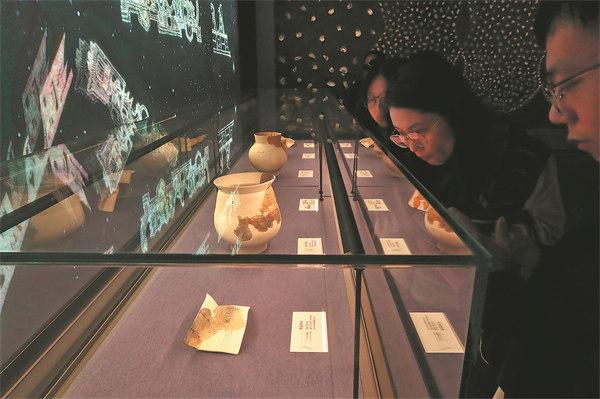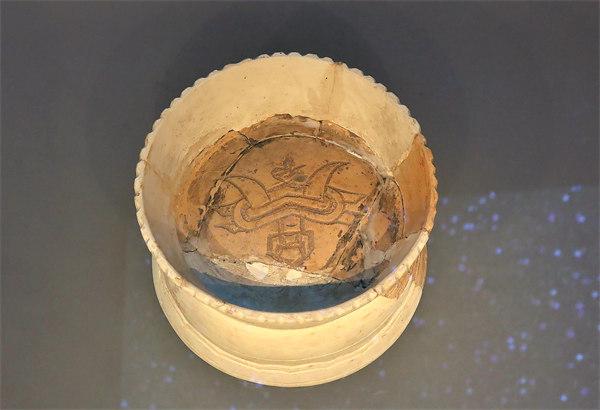
Artifacts on display at the Gaomiao site museum in Hongjiang, Hunan province. [Photo by Jiang Dong/China Daily]
A vivid panoramic view unfolds on the northern bank of the Yuanjiang River in the middle reaches of the Yangtze River. About 7,800 years ago, the area saw human activity for more than two millennia. They were good at fishing and hunting, and ate various shellfish. They were also innovative, and invented white pottery and various patterns on ceramic products.
The insight into their society was gained through archaeological efforts on the Gaomiao site in Hongjiang, Hunan province in 1991,2004 and 2005, making the site listed as one of China's top 10 archaeological discoveries for 2005.
In recent years, local people are quick to highlight the discoveries to the public.
Covering about 30,000 square meters, Gaomiao has yielded rice from 7,400 years ago. Gaomiao people began making white pottery more than 7,600 years ago. The patterns on pottery, including birds, beast faces and eight pointed stars are vivid reflections of Gaomiao people's spiritual world.
The biggest threat to the site is rising water levels from heavy rainfall or flooding from the nearby Yuanjiang River.
Therefore, a rainwater diversion and drainage system has been established, including the installment of a surrounding revetment. Professionals patrol the site regularly and 24-hour cameras monitor.
Realizing its value, local people who reside nearby no longer extract soil for building or road construction from the site.
"Generally speaking, the site has been protected well," says Yang Yalin, director of the design and construction department of Gaomiao's protection and utilization center in Hongjiang.
A great deal of effort has been made to promote the site and its value, as elements from Gaomiao have been widely applied in local tourist development.
For example, a creative zone featuring white pottery from Gaomiao has been established not far from the site, where visitors can participate in cultural-experience activities like making pottery.
The patterns found from the site are often used as decorations for buildings in the city.
An archaeological site park of Gaomiao has been built, where visitors can gain an understanding of the site through exhibitions at the Gaomiao site museum and visits to the site area. The natural environment of the site has been preserved to show its rustic charm.
Visitors can also enjoy drinks in a specified area and buy cultural and creative products in the museum, says Yang.
Local people help in the operations of the park because it offers positions for them, and they can run small businesses within the park area.
"Now, the Gaomiao archaeological site park is transforming the site from an archaeological site into a cultural landmark," says Xiang Xinlin, deputy director of the center.
Hongjiang boasts rich farming cultural resources. Besides the Gaomiao site, it also has the Anjiang Agricultural School on the other bank of the river where late Chinese scientist Yuan Longping worked for 37 years during which he developed the first hybrid rice strains.
"On the two banks of the Yuanjiang River, the ancient Gaomiao site and modern agricultural creations shine brightly together," said Shan Jixiang, former director of the Palace Museum in Beijing, at a seminar discussing the protection of Gaomiao site in 2023. "This symbolizes an important inheritance of Chinese farming civilization."
Hongjiang is building its tourism characterized by farming culture, establishing a series of cultural and tourist projects covering all the related sites, and linking them in travel routes.
"Gaomiao is increasingly becoming a cultural and tourist complex combining scientific research, museum display, knowledge popularization and relaxation. A unique cultural landmark to seek origins of Chinese civilization, it drives the development of local culture and economy," says Xiang.

Part of a white pottery vessel with intricate patterns at the Gaomiao site museum. [Photo by Jiang Dong/China Daily]
Source: Ecns








